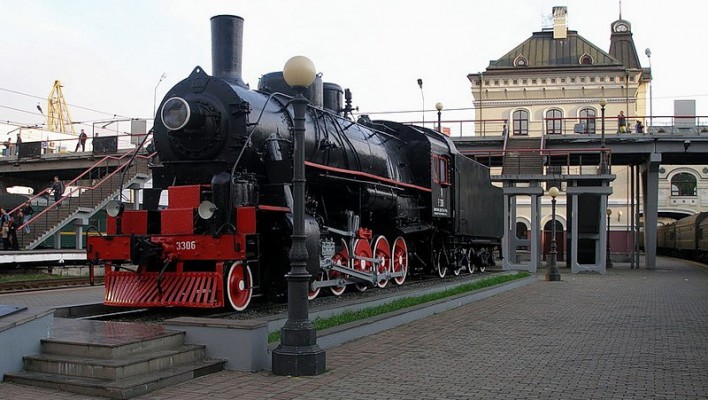Train Station
No matter by what kind of transportation you reach Vladivostok, you should visit its train station without fail. Located at the downtown, its gorgeous building is one of the oldest and most beautiful ones in Primorsky Krai's capital. Being recognized the unique engineering creation, train station's building has the status of historical and architectural monument of federal importance and is one of the most recognizable Vladivostok's symbols.
The city train station was built as the last point of the Trans-Siberian Railway - the longest railway in the world that connects Moscow and Vladivostok - and is the utmost point of the immense Russia and the terminal point for everyone traveling from country's European part to the east.
The Vladivostok train station was founded simultaneously with the railway in 1891. The Tsesarevich Nicholas Alexandrovich - future Russian Imperator Nicholas II - who visited the city within the framework of his Eastern trip participated directly in its foundation. Two years later the train station was solemnly opened. Its first stone building was notable for virtually ascetic simplicity and modesty of its forms. It was one-storey in the center and two-storey on the sides, and was covered with iron roof. Station's floor was flagged with earthen Japanese flagstones that survived until now. Ancient tiles have also partially survived on the walls. Ovens, made of Dutch tiles, were installed inside. They not only heated the train station's premises during the cold season, but adorned its interior as well.
However, in 1912, with Yaroslavsky terminal's construction in Moscow - the trains started their way to the Far East there - the Vladivostok train station was rebuilt in its image and likeness. In this way, architecturally finished train stations appeared on both sides of the Trans-Siberian Railway. Local residents used to joke that upon their arrival in Vladivostok a Muscovite who has taken a train from the Yaroslavsky terminal will see the Yaroslavsky terminal again.
The Vladivostok train station's building was reconstructed in the style of the most beautiful monuments of 17th century's Russian architecture. The symbol of Russia's power - two-headed eagle - was placed on its roof, the mosaic coat of arms of Promorsky Krai appeared on the western facade, and the coat of arms of Moscow - the Saint George riding the horse and slaying a dragon - adorned the eastern one. Building's walls were adorned with relief images from glazed ceramics depicting Russian folk fairy-tales' plots. All these symbolized Vladivostok's unity with Russia's central regions and its close link with ancient traditions of Russian culture.
When the Soviet government took over the power, train station's building's appearance underwent significant changes: two-headed eagle was pulled down, panels with coats of arms, pictorial and relief scenes were covered with thick layer of plaster, and facades were repainted. Vladivostok train station preserved such look until the late 20th century, when tandem of talented Italian and Russian specialists restored the historical building in its initial splendor.
Train station's pride is its hipped roof, decorated with metallic coping and small figured gable windows. Building's walls are covered with mosaics depicting horsemen, fairy birds, berries and fruits. The memorial ancient steam locomotive is placed on the railway platform in front of the train station, and there is the stela crowned with the figure of the two-headed eagle near it. The number 9288 is inscribed on the stela and identifies the distance between Moscow and Vladivostok in kilometers.
Today you can not only admire the magnificent historic building, but walk along the age-old block pavement that was laid on the train station's square for Tsesarevich's visit in the late 19th century.
















